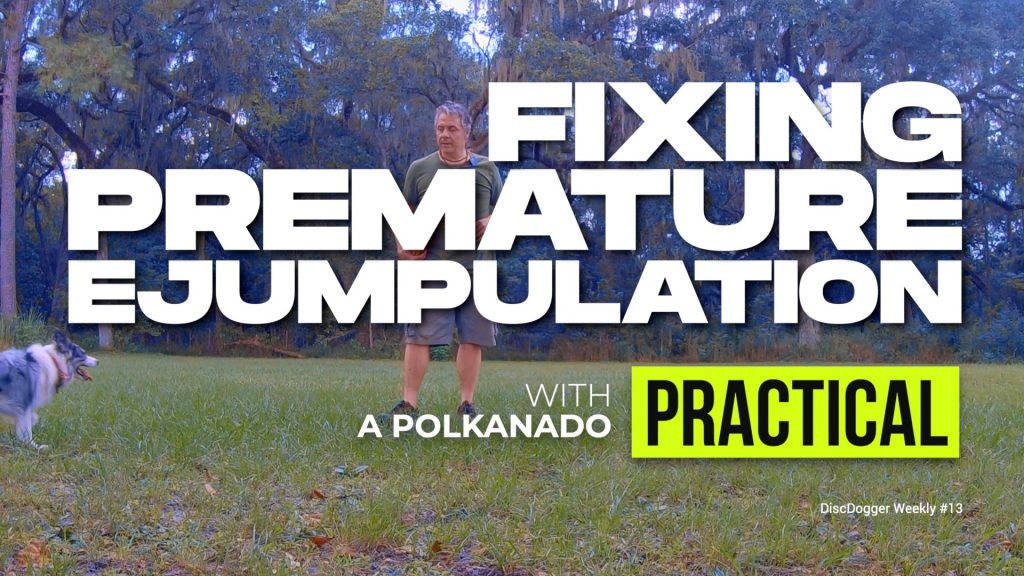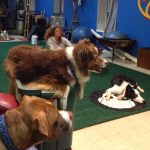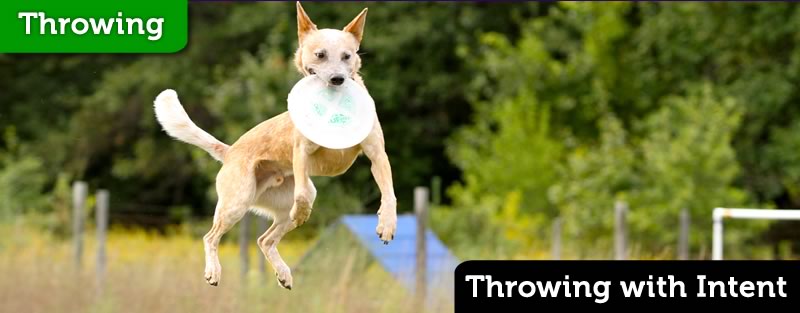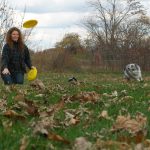
Upside Down Throws for Disc Dog Collection and Tracking
Upside down throws create disc dog collection and tracking opportunities and limit the opportunity for over-pursuit. Because of their strange flight pattern, upside down throws ask your dog to pay attention to the disc and it’s trajectory rather than just run around out there chasing plastic.
Perfect Throws Are Too Predictable and Not Perfect Enough
Polka is Apryl’s dog. Apryl is a very proficient thrower. She throws well and her discs fly predictably – perhaps too predictably.
Predictable flight trajectories enable the dog to spot Spot is a “go to a place”, or “go to a mat” behavior. This means that the dog seeks out and performs a duration behavior on a spot of the handler’s choosing. A... More check the position, speed, and angle of the disc, do a quick calculation and then meet the disc at the spot where a catch can be made. Predictable throws don’t need to be tracked. They are predictable, the dog knows where they are gonna be, so why track them?
Spot is a “go to a place”, or “go to a mat” behavior. This means that the dog seeks out and performs a duration behavior on a spot of the handler’s choosing. A... More check the position, speed, and angle of the disc, do a quick calculation and then meet the disc at the spot where a catch can be made. Predictable throws don’t need to be tracked. They are predictable, the dog knows where they are gonna be, so why track them?
The problem with this is that discs are not balls, and regardless of how well thrown they are not completely predictable. This sets up a situation where a dog can be quite successful with poor tracking and collection technique. It’s similar to a ball player making one handed catches – sure they can be done but they are a bad habit that will cost you catches and will lead to mistakes.
Better Throwing Will Not Help
Great throwers can and do overcome this, but the problem is still there and will grow over time. The more it happens the better the handler has to throw, the better the handler throws, the more predictable the flight path of the disc and the less the dog has to pay attention. This situation spirals out of control and pretty soon your dog is not only not catching well, but requires perfect placement on every toss. That’s not fair to any handler and not fair to your team.
Better throwing leads to less tracking. Less tracking means collection will not be thoughtful and well planned, but will instead be reflexive and reactive. How is the dog supposed to learn how to collect for catches and leaping catches if they are not able to track the target well?
You Can’t Predict the Unpredictable
Unpredictable throws must be tracked because they are not predictable. They must be tracked moment by moment. The dog’s eyes and mind must be focused on the target during flight, not the catch at the finish. The dog’s body must follow the disc, moment by moment, and must be ready to move in any direction and in position to make the catch at the finish.
Upside down throws are unpredictable. In this video, Polka is initially unable to predict the flight trajectory of the upside down throws. A couple reps of being unable to predict the flight of the disc, and Polka starts to read the disc, moment by moment, focusing intently upon the target so she has a hope of making the catch.
Stop Predicting and Start Responding
This change in Polka’s approach to catching the disc is about being responsive to the flight of the disc. Rather than being predictive, knowing where it is supposed to be, running there, and leaping before she looks, she starts to be responsive to the action of the target. She starts to read the trajectory, moment by moment, and take the necessary steps to navigate the catch.
Responding to the target is tracking. Once she’s got some experience tracking she starts to get some practice collecting as a response to her tracking of the target.
The more this happens, the better the dog has to get at tracking and collecting. The better the dog gets at tracking and collection, the more likely they are to make good decisions, to be in a good position to leap, and to be successful at catching. This is likely to spiral into control.
Memorable Mistakes vs Amazing Attempts
Normally, Polka misses discs in spectacular fashion, and she barely misses them. Of course there are some crazy attempts that were never going to work, but they were amazing attempts. The memory of the exchange is that of an amazing attempt,”Man, I almost got that one – that was epic! I’ll get the next one for sure…”
With the upside down throws, poor tracking and collection doesn’t even allow for an attempt, let alone an amazing one. Polka made such great mistakes that she could not even try for a catch. “What happened? I mean, I wasn’t even on the right planet to make that catch… What do I need to do differently to get a chance at making a catch?”
One of these two situations changes the behavior of a disc dog and the other reinforces missing. The memorable mistake makes the dog change behavior while the amazing attempt is extremely reinforcing.
Upside Down Throws Turn Mistakes Into Learning Opportunities
Mistakes can be looked at as failures to execute or as learning opportunities. If your dog is making the same mistake and missing all the time, odds are that the mistake is just a failure to execute.
Polka clearly thought her mistakes were simply failures to execute,”Whoa, dat was awesome, I almost got that one…” As soon as she ran into the upside down tosses in this video it became clear to her that her problems were more than a simple failure to execute. It was obvious that she was missing something. “Wow! That didn’t go as planned… What do I need to do differently?”
The upside down throws turned that failure to execute into a learning opportunity, and Polka grabbed it.









Perfect timing on this, will work on it tomorrow evening.